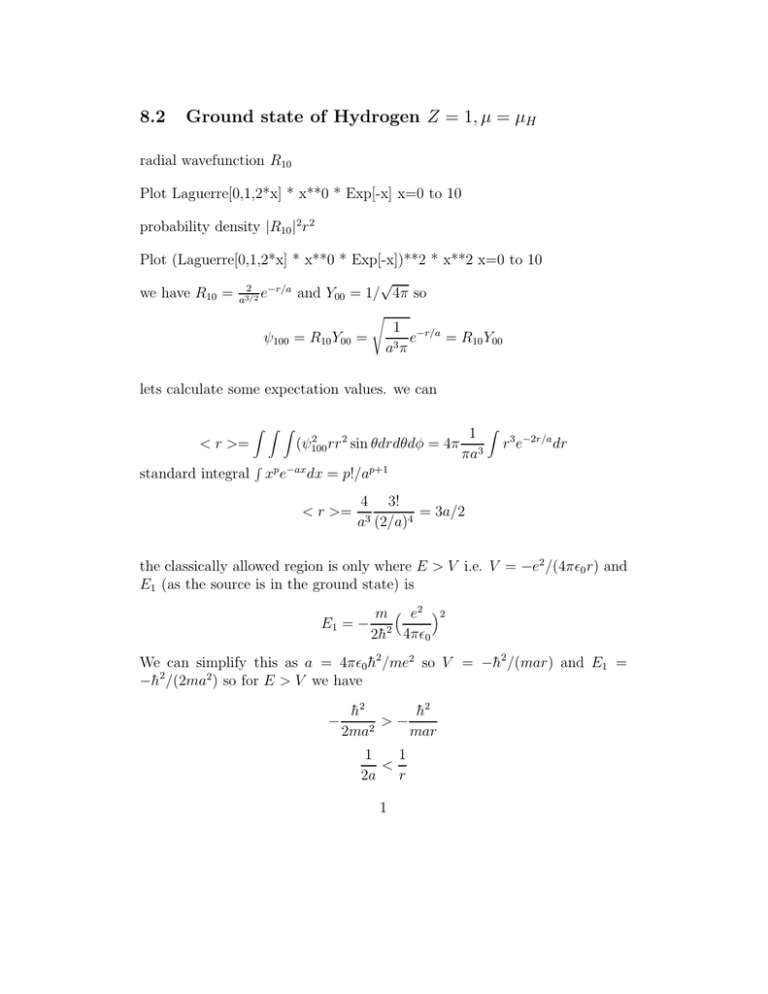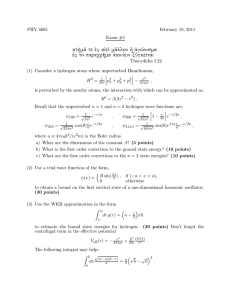8.2 Ground state of Hydrogen Z = 1,µ = µ
advertisement

8.2 Ground state of Hydrogen Z = 1, µ = µH radial wavefunction R10 Plot Laguerre[0,1,2*x] * x**0 * Exp[-x] x=0 to 10 probability density |R10 |2 r 2 Plot (Laguerre[0,1,2*x] * x**0 * Exp[-x])**2 * x**2 x=0 to 10 √ 2 we have R10 = a3/2 e−r/a and Y00 = 1/ 4π so ψ100 = R10 Y00 = s 1 −r/a e = R10 Y00 a3 π lets calculate some expectation values. we can < r >= standard integral Z Z Z R 2 (ψ100 rr 2 sin θdrdθdφ 1 = 4π 3 πa xp e−ax dx = p!/ap+1 < r >= Z r 3 e−2r/a dr 4 3! = 3a/2 a3 (2/a)4 the classically allowed region is only where E > V i.e. V = −e2 /(4πǫ0 r) and E1 (as the source is in the ground state) is E1 = − m e2 2 2h̄2 4πǫ0 We can simplify this as a = 4πǫ0 h̄2 /me2 so V = −h̄2 /(mar) and E1 = −h̄2 /(2ma2 ) so for E > V we have − h̄2 h̄2 > − 2ma2 mar 1 1 < 2a r 1 so classically we have r < 2a. But this is a wavefunction so there is some probability we find the electron beyond r = 2a which is 1 a3 π Z Z Z 1 r sin θdrdθdφ = 3 4π aπ −2r/a 2 e Z ∞ r 2 e−2r/a dr = 0.24 2a where we just do the integral numerically! But we could have saved ourseves work on < r > by using the fact that the Ylm are already normalised over θφ integrals so < f (r) >= Z Z Z ∗ ∗ Rnl Ylm f (r)Rnl Ylm r 2 sin θdθdφ = Z ∗ Rnl (f (r)Rnl )r 2 dr So lets find < V > the simple way < V >=< − =− e2 4 4πǫ0 a3 e2 e2 >= − 4πǫ0 r 4πǫ0 Z Z ∗ −1 R10 r R10 r 2 e−2r/a rdr e2 4 1! e2 −h̄2 =− =− = 4πǫ0 a3 (2/a)2 4πǫ0 a µa2 8.3 Expectation values from more complex orbitals ψ210 = R21 Y10 , where R21 = r −r/2a √1 e 24a3 a and Y10 = 3 4π 1/2 cos θ find the probability that the electron is in the ’arctic circle’ - i.e. within the range θ = 0 − 23.5◦ . prob= R 23.5 R 2π R ∞ 0 0 0 2 R21 Y102 r 2 sin θdrdθdφ = Z 0 23.5 Z 2π 0 Y102 sin θdθdφ 2 3 23.5 cos2 θ sin θdθ = 2π 4π 0 3 = 0.0762 = 0.11 2 Z compare to classical - we would have uniform probability with angle. so we will just integrate our angle surface element for our angle raneg. But this needs to be normalised so we divide by the integral over the total angle range. R 23.5 R 2π = 0R π R 2π0 0 = 0 sin θdθdφ sin θdθdφ 2π0.0829399 = 0.041 2π2 and we can see this by looking at the shape of the 3D orbitals.... 8.4 Energy levels Put hydrogen in some stationary state ψnlm . it should stay there forever. But perturb it slightly - maybe a collision with another atom/electron/photon then the electron may undergo a transition to another stationary state either by absorbing energy or emitting it. such perturbationas are always present, so such tranistions - quantum jumps - are constantly occuring. But since these transitions occur between levels of fixed energy, then the emitted photon depends on the difference in energy between the initial and final states Eγ = Ei − Ef = −13.6 8.5 1 1 − n2i n2f Hydrogen isoelectronic sequence any ion with atomic number Z which is ionised so that there is only 1 electron left should be described by the same equations, but with V (r) = −Ze2 /(4πǫ0 r). 3 This affects both atom size and energy as a = 4πǫ0 h̄2 /(mZe2 ) so this scales as a = aH (µH /µ)(1/Z) while En (Z, µ) = µµH Z 2 E1H /n2 so then we can treat ionised helium, which has more or less same mass µHe ≈ µH ≈ me a 1st energy level of -13.6.4 = -54.4 eV. and should have all size scales which are 2x smaller than Hydrogen. similarly, we could have different reduced mass µZ e.g. for positronium where the proton is replaced by a positron so the reduced mass µ = MA MB /(MA + MB ) = me /2 then a = aH /µ so the size scale is 2x larger, and E ∝ µ so the energy is 2x smaller. and the wavefunctions are just derived with the size scale a. e.g. ψ100 = (πa3 )−1/2 e−r/a where a = aH (µH /µ)(1/Z) so for a Hydrogen-like ion with change Z and reduced mass µ = µH ) ψ(r) = (π(a3H /Z 3 )−1/2 e−rZ/aH so < r >= = Z Z Z Z3 ψ rr sin θdθdφ = 3 4π πaH 2 2 Z r 3 e−2Zr/aH dr 4Z 3 3! 4Z 3 3! 3aH = = =< r >H /Z 3 3 4 4 aH (2Z/aH ) aH (2/aH ) 2Z so as expected, all the typical sizes scale with 1/Z 8.6 Comparison in detail with Hydrogen The balmer line is actually 2 lines, yet our schroedinger solution did not give us this! so maybe its that hydrogen is not just proton-electron, there is some admixture of deuterium. so µd = 2mp me /(2mp + me ) while µH = 2mp me /(2mp + me ) so the energies will be slightly different En = µµH EnH = (2mp me )/(2mp + me )EnH = 1.0003EnH but this is a BIGGER shift than is observed,. 4 so where do the small line shifts come from??? To understand Hydrogen at this level of detail we have to do a lot more work - and in particular, we need to do more work on angular momentum, and especially spin angular momentum. And since we are going to be looking for TINY effects, we are going to treat these as a small perturbation so rather than solve things exactly, we are going to do perturbation theory to get approximate answers. 5



